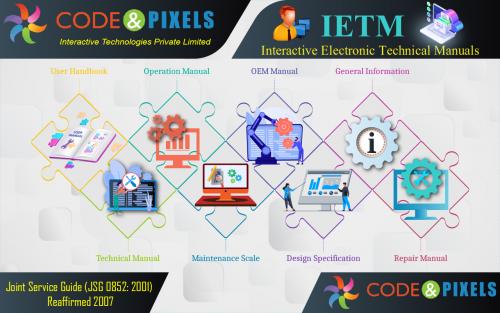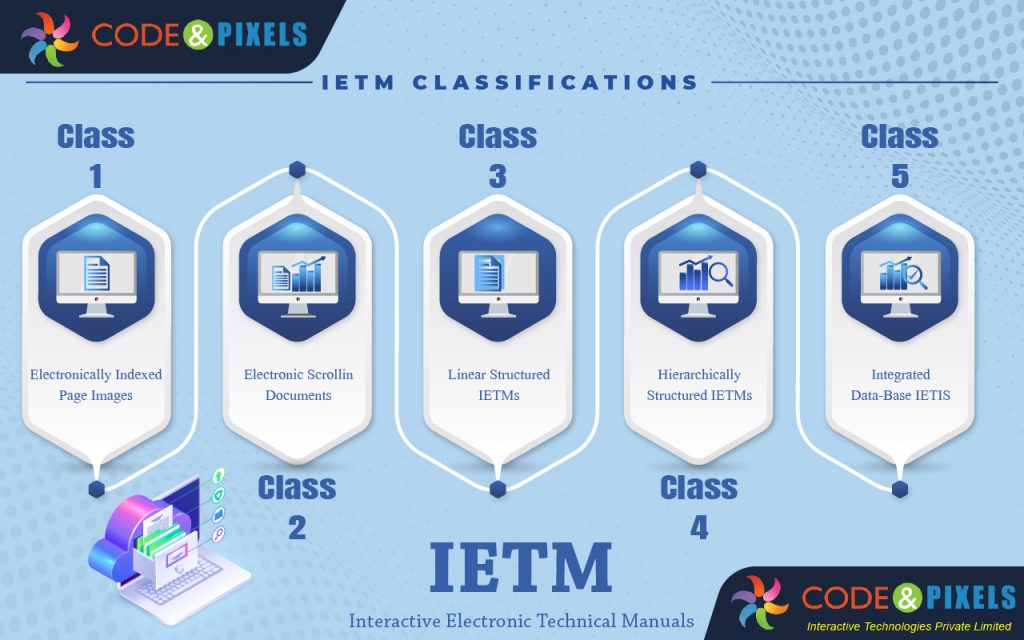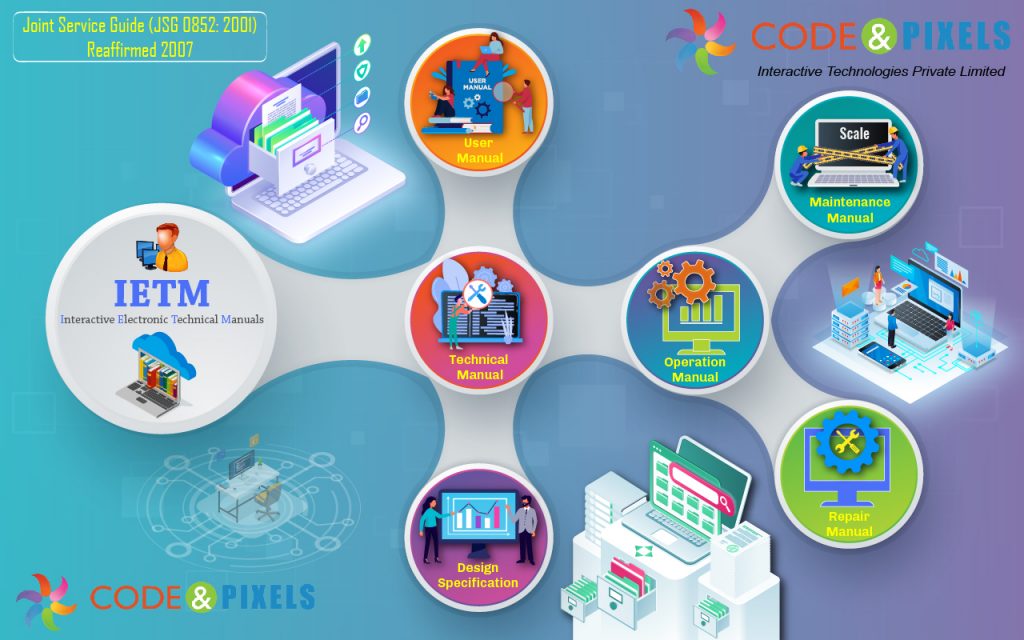Guidelines to OEMs IETM

General Guidelines to be followed by OEMs while making Manuals
This document briefly covers the guidelines to be followed by OEMs while preparing manuals.
- Administrative Information
- Introductory information
- Definition of Acronyms, Terms and Abbreviations
Above information is also required from OEMs along with approved manuals which are to be integrated in to IETM software.
Multiple Skill Level Tracks, Comprehensibility can be followed as per the requirement of system that is to be delivered. (To be decided by OEM)
Quality of graphics section is highly advisable to follow. Items and systems hierarchy section is also good to follow.

1. Administrative Information:
All IETM shall contain the following administrative information for subsequent user selectable display:
- Identification of the “Title of The Technical Manual”, assigned “Technical Manual Number”, as applicable.
- Classification Level of the IETM (shall also be presented upon initial entry to the IETM by the user)
- Date, baseline date and dates of the latest/all previous changes.
- Verification, change or revision status as applicable.
- Method of obtaining additional copies and the format of such electronic copies
- Distribution statement.
- Summary of documents and/or technical manuals that are referred in the IETM but not included in the automatically accessible data (hyperlink) available to the IETM.
2. Introductory Information:
All IETM shall contain information, which explains the purpose and scope (e.g., organizational level troubleshooting and corrective maintenance for a particular system), content, and organization of the IETM.
This section shall present the range of tasks covered by the IETM and relate the purpose and scope of the manual.
3. Definition of Acronyms, Terms and Abbreviations:
- A glossary of terms used in the IETM including all acronyms, abbreviations and special terms shall be incorporated in the IETM and shall be directly accessible in all IETM presentations.
4. Warnings, Cautions and Notes:
Technical information shall be supplemented with warnings, cautions and notes in such a way as to:
- Attract the user’s attention to correct practices, procedures and conditions which, if not adhered to, could lead to injury or equipment damage.
- Warn the user against performance of certain hazardous actions, and/or,
- Follow specific steps leading to safe performance of the procedures.
5. Multiple Skill Level Tracks:
- When required, technical information shall be available in multiple skill level tracks.
- For example, in the case of novice level and expert level skills, technical information shall be available in each of the two separate and complete tracks representing the two skill levels.
- The novice level track shall contain all information necessary to carry out a task step by step, while the expert level track may provide only a checklist or a description in broader terms.
- The expert would have the option of referring to the novice level information also.

6. Comprehensibility:
The following guiding principles shall be followed to ensure comprehensibility of data in an IETM:
- Information should be in a descriptive text manner. This text must be consistent in style, terminology and format.
- The functions of the system/component, the inputs, outputs, interfaces and principles of operation are to be described.
- Any special features are to be listed and explained.
- Location of the component/part in the system is to be indicated.
- Each paragraph of the text should be limited to a single idea. Each sentence should be limited to a single thought. Short and familiar words are to be used. Rules of Service writing shall be adhered to.
- Length of a sentence shall not exceed 20 words. The average paragraph shall not exceed 6 sentences.
- Steps and explanations shall be constructed as fully integrated text and graphics modules.
- Text shall be presented in a logical order; e.g., as in an operational sequence or in signal flow sequence.
- The IETM shall contain only the information required. Any additional information which could be useful, but not essentially required, shall be provided as HELP
7. Quality of Graphics:
- Graphics shall be prepared to a scale that ensures that all Essential details are legible. Line widths should be chosen so as to be seen clearly on any display. However it should be kept in mind that intensive use of graphics would slow down a system.
a. Angle of view:
- The graphics should represent the views that are generally used. If necessary, more than one view should be provided.
b. Schematic and Wiring Diagrams:
- Cable schedules, schematics and wiring diagrams displayed along with an accompanying text should be displayed so as to contain only the information referenced by the text with which they are displayed.
- However, the user should be able to see the complete diagram or list if it can be displayed on the screen.
c. Flow Charts:
- These are to be drawn from left to right or from top to bottom.
- The diagrams should indicate the details referenced by the accompanying text.

8. Item/System Hierarchy:
- The weapon system or other equipment that is being maintained and operated is composed of several layers of subsystems, components, and parts.
- This hierarchical representation of the equipment being maintained and operated shall be accomplished by use of a system element that is used recursively, and which decomposes the equipment into only those components that are being maintained or operated. Each component of this hierarchy has associated with it one or more of the following four categories of information.
- Descriptive information
- Procedural information
- Troubleshooting information
- Parts information
a. Descriptive Information:
Descriptive information may provide information on system (subsystem, component, and part), physical arrangement, functional behavior, theory of operation, and other aspects. Descriptive information shall contain a hierarchy of narrative paragraphs. Paragraphs, in turn, may refer to primitive elements.
b. Procedural Information:
- Procedural information shall be composed primarily of task statements.
- Each task element shall be associated with attributes which provide related information such as: estimated completion time; maintenance level(s) where the task is to be performed; required conditions which must be met before performing the task; and the number of people required to perform the task.
- A procedural element may be linked to other elements, which define the supported equipment, and consumables that the task requires, through the establishment of appropriate relationships.
c. Troubleshooting Information:
Troubleshooting information shall contain data necessary to isolate faults found in a system. Troubleshooting information shall contain fault elements, fault state elements, test elements, outcome elements, and rectification elements.
Fault Elements:
- Fault elements shall identify potential faults, which might occur in the system.
- Fault state elements. Fault state elements shall present a list of faults implicated as the result of a test that has been performed. Each suspected faultin the list shall be weighted, based on the probability that it is the cause of theobserved malfunction. The fault state element may also present a list ofpossible faults that have been eliminated from consideration as the result of tests performed.
Test Elements:
Test elements shall contain a link to the proceduralinstructions a technician must follow to carry out a required task at a particularjuncture in the troubleshooting procedure. Test elements shall also provide allpossible test outcomes.
Outcome Elements
Outcome elements shall contain definitions of new fault states associated with the results of a particular test. Outcome elements shall also contain a description of the state of the item being maintained. The final outcome element of a fault isolation procedure shall have a relationship, which associates it with an identified fault. The identified fault has, in turn, associated with it the initial element of the appropriate
Corrective maintenance action.
Rectification Elements:
Rectification (i.e. corrective maintenance actions) elements shall contain references to procedural rectification tasks, checkout tests used to report the success of completed rectification tasks, and a list of all faults that the rectification shall repair.
9. Parts Information:
Two types of parts information shall be included:
Maintainer/Operator Information, and Supply Information: Elements containing either type shall refer explicitly to corresponding elements of the other type. Parts information provided for a system maintainer and/or operator shall include such items as units per assembly, usable-on code.
Mean Time Between Failures (MTBF), and reference designator, if applicable.
(ii) Parts information provided for the parts supply process shall constitute unambiguous identification on a part so that it can be reordered, and may consist of such items as: the part number, description, source, system, maintenance etc.,
10. Naming Convention for Version Control:
Every IETM shall clearly be identified by a
- “Title” followed by a “Version Number”, indicated by 2 integers, starting from “00”. Everychange from the release of the IETM will be clearly identified as an incremental integer from“00”.
For example:
- “IETM for Radio Station RRF Ver. 00” – Initial release version
- “IETM for Radio Station RRF Ver. 01” – First revised version
Post Your Ad Here

Comments